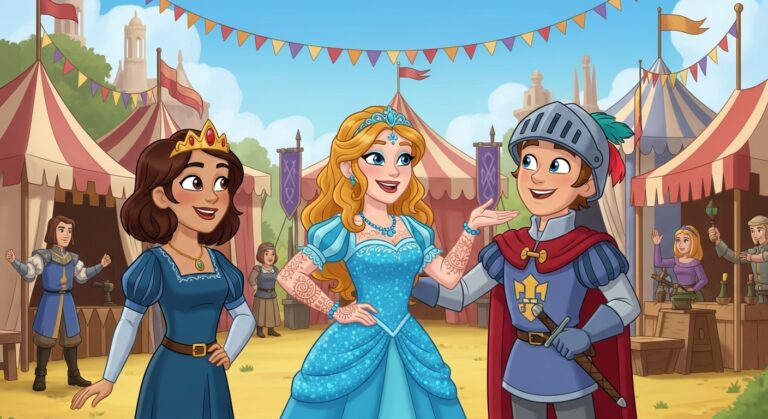In a quaint town nestled between rolling hills, an 18-year-old girl named Emma found herself in a delightful predicament. A vibrant renaissance fair was in the works, and her two closest friends, Maya and Jake, had extended an invitation to join them, along with another couple, Sarah and Max. Emma was thrilled at the prospect of spending a day filled with medieval merriment, even if it meant being the fifth wheel in a group of couples. She had always loved the idea of dressing up, and the renaissance fair was the perfect occasion to unleash her inner princess.
As the days ticked down to the fair, Emma’s excitement grew. She envisioned herself twirling in a flowing gown, adorned with a delicate hennin—a traditional headpiece worn by noblewomen of the era. It was more than just a costume; it was a chance to embody the elegance and grace she admired in the stories she had grown up with.
When she met with her friends to discuss costume ideas, Emma’s heart raced as she shared her vision. “I want to be a princess!” she declared, her eyes sparkling with enthusiasm. However, her excitement quickly dimmed when Maya and Jake revealed that they had already decided on their own costumes: Maya would be the princess, dressed in a stunning green gown, while Jake would be her chivalrous knight.
Emma felt a twinge of disappointment but remained supportive. “That’s awesome! I could wear blue instead of green,” she suggested, hoping to find a compromise. But to her dismay, Maya and Jake were not swayed. They argued that having Emma as another princess would confuse the dynamics of their couple’s costume. “It’s just weird,” Maya insisted. “People won’t know who is with whom.”
Emma’s heart sank. She understood their perspective, but the notion of being denied her dream costume left her feeling frustrated. “It’s just a costume! Can’t I be a princess too?” she pleaded, feeling a mix of disbelief and hurt. The conversation quickly turned to alternatives, but each suggestion fell flat. Emma proposed being Maya’s lady-in-waiting, a role that would still allow her to bask in the royal aura. But Maya dismissed the idea, insisting it was not the same.
As the days passed, Emma wrestled with her disappointment. The more she thought about it, the more she felt it was unfair to dampen her enthusiasm for the sake of their couple’s dynamic. After all, the renaissance fair was meant to be a celebration of fun, creativity, and friendship. Why should she have to suppress her desire to embrace the magical experience of being a princess?
Seeking solace, Emma turned to her other friends for advice. They encouraged her to stand her ground and pursue what made her happy. “You deserve to wear what you want! It’s your experience too,” one friend chimed in. Empowered by their support, Emma decided it was time to take a stand.
On the eve of the fair, she made a bold choice. She crafted a beautiful blue gown that sparkled like the night sky, complete with a matching hennin. Embracing her individuality, she adorned herself with a touch of whimsy, adding accents of silver and gold to her outfit. Emma felt radiant, ready to step into her role as a princess, regardless of what anyone else thought.
The next day, as the sun rose over the fairgrounds, Emma joined her friends for the event. The atmosphere buzzed with excitement as laughter and music filled the air. Colorful tents lined the pathways, while performers showcased their talents, drawing crowds that thrived on the infectious energy of the fair.
Maya and Jake arrived, dressed as they had planned, and Emma could see the surprise in their eyes as they took in her stunning outfit. “Wow, Emma! You look amazing!” Maya exclaimed, a hint of begrudging admiration in her voice. But Emma didn’t need their approval; she felt like a true princess, radiating confidence as she stepped into the bustling crowd.
As the day unfolded, Emma was swept away by the enchantment around her. She engaged in lively games, watched jousting tournaments, and even danced beneath the whimsical flags that fluttered in the breeze. It was everything she had hoped for and more. Throughout the day, she received compliments from strangers, who admired her gown and the way she carried herself with grace. Little did she know how much her confidence was inspiring others around her.
In a serendipitous turn of events, the trio of friends decided to participate in a group photo-op, where attendees could pose with knights, jesters, and, of course, princesses. Emma stood proudly in the center, flanked by Maya and Jake, who had reluctantly agreed to join in after seeing how much fun she was having. The laughter that erupted as they posed for the picture captured the essence of friendship, acceptance, and the joy of individuality.
As the fair drew to a close, Emma felt a sense of fulfillment wash over her. She had not only embraced her dream of being a princess but had also shown her friends that it was possible to celebrate individuality within a group dynamic. Maya approached her, a newfound respect in her eyes. “I’m sorry for not supporting you earlier. You really owned it today, and I admire that.”
Emma smiled, her heart swelling with happiness. “Thank you! It feels good to be true to myself.”
That day, Emma learned that while friendships are essential, it’s equally important to honor one’s own desires and aspirations. The renaissance fair became a cherished memory, a testament to the magic that unfolds when one dares to stand out and embrace their unique journey.
—





0 Comments